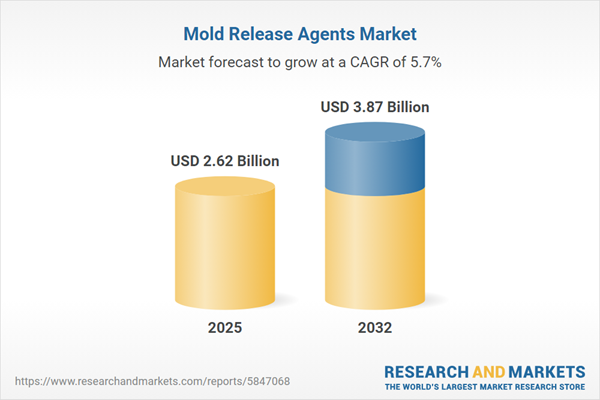Speak directly to the analyst to clarify any post sales queries you may have.
For senior manufacturing executives evaluating process optimization, the mold release agents market presents direct pathways to enhanced efficiency, compliance, and sustainability goals. Increasing regulatory oversight and mounting environmental expectations are driving organizations to reassess the role of mold release agents as foundational enablers for agile, responsible production.
Mold Release Agents Market Snapshot: Growth Outlook and Technology Trends
The mold release agents market is undergoing consistent expansion, with activity propelled by demand from automotive manufacturing, electronics, and varied industrial sectors. Organizational focus is shifting towards process chemicals designed for stringent environmental standards, supporting a dual mandate of operational efficiency and regulatory compliance. Advancements in agent formulations address evolving requirements, while procurement teams increasingly prioritize digital acumen and transparent sustainability outcomes. The sector’s transition to digital monitoring and streamlined logistics is also strengthening supply chain responsiveness and contributing to reliable, long-term operations.
Scope & Segmentation: Core Factors Shaping the Mold Release Agents Market
Strategic segmentation assists leaders in aligning procurement frameworks and production processes with emerging market forces and compliance pressures. This structure supports sharper resource allocation, targeted supplier selection, and agile operational planning across the following key categories:
- Chemical Types: Fluorocarbon-based agents address high-temperature, performance-critical environments; silicone-based formulations, including methylphenyl and polydimethylsiloxane, enable flexible production lines; synthetics such as acrylic, ester, and polyethylene meet advanced process standards; vegetable oil-based options appeal to firms emphasizing sustainability and workplace safety.
- Physical Forms: Emulsions provide water-based, low-emission mechanisms; liquids facilitate precision dosing and automated control; powders fit batch-specific requirements; sprays ensure consistent application for rapid throughput operations.
- Applications: Utilized across tire manufacturing and component molding in automotive, efficiency optimization in consumer sectors, batch accuracy in electronics, and uniform quality in metal, rubber, and plastics processing.
- Distribution Channels: Traditional offline channels center on consultative supply partnerships, while digital purchasing—encompassing e-commerce and direct web-based sourcing—promotes acquisition speed and data-based procurement.
- Key Regions: The Americas benefit from robust infrastructure; EMEA advances with strong compliance systems and digital tools; Asia-Pacific accelerates growth by integrating technology and regional network investment.
Mold Release Agents Market: Strategic Insights for Senior Decision-Makers
- Fluorocarbon and silicone-based agents help manufacturers adapt to shifting compliance expectations while reinforcing process stability.
- Transitioning to bio-based or lower-emission alternatives requires deliberate change management to sustain production continuity and reduce operational risk.
- Deploying digital intelligence and production automation enables prompt line adjustments, minimizing downtime and preserving product consistency.
- Building robust supplier relationships unlocks early access to next-generation formulations, enhancing readiness for emerging manufacturing standards and regulations.
- Emphasizing regionally adapted sourcing increases supply chain resilience and supports adherence to region-specific compliance landscapes.
Tariff Impact and Supply Chain Adjustments
Changes in U.S. chemical import tariffs have amplified the significance of proactive supply chain strategies in the mold release agents sector. Companies are responding by reevaluating supplier portfolios and, where feasible, prioritizing domestic and regional partners. This shift seeks to maintain supply stability, hedge against international trade disruptions, and guarantee access to critical process chemicals for uninterrupted production.
Methodology & Data Sources
This market analysis consolidates insights from top chemical producers, procurement stakeholders, and operational users. The methodology blends patent reviews, regulatory analysis, and vetted secondary sources to deliver an up-to-date view on sector advancements and compliance practices.
Why This Mold Release Agents Market Report Matters
- Empowers business expansion, portfolio optimization, and sustainable operations through actionable market intelligence for manufacturing leaders.
- Enables agile response to shifting regulations, competitive trends, and supply chain evolution by supplying holistic, data-driven analysis.
- Improves procurement and R&D decision-making with benchmarks supporting ongoing regulatory and environmental commitments.
Conclusion
Ongoing analysis of the mold release agents market equips organizations to sustain operational performance, anticipate compliance trends, and solidify business resilience within a changing industry landscape.
Additional Product Information:
- Purchase of this report includes 1 year online access with quarterly updates.
- This report can be updated on request. Please contact our Customer Experience team using the Ask a Question widget on our website.
Table of Contents
3. Executive Summary
4. Market Overview
7. Cumulative Impact of Artificial Intelligence 2025
Companies Mentioned
The companies profiled in this Mold Release Agents market report include:- Dow Inc.
- Evonik Industries AG
- Parker-Hannifin Corporation
- Clariant AG
- Henkel AG & Co. KGaA
- 3M Company
- Arkema S.A.
- BASF SE
- The Lubrizol Corporation
- NOF Corporation
Table Information
| Report Attribute | Details |
|---|---|
| No. of Pages | 188 |
| Published | November 2025 |
| Forecast Period | 2025 - 2032 |
| Estimated Market Value ( USD | $ 2.62 Billion |
| Forecasted Market Value ( USD | $ 3.87 Billion |
| Compound Annual Growth Rate | 5.7% |
| Regions Covered | Global |
| No. of Companies Mentioned | 11 |









